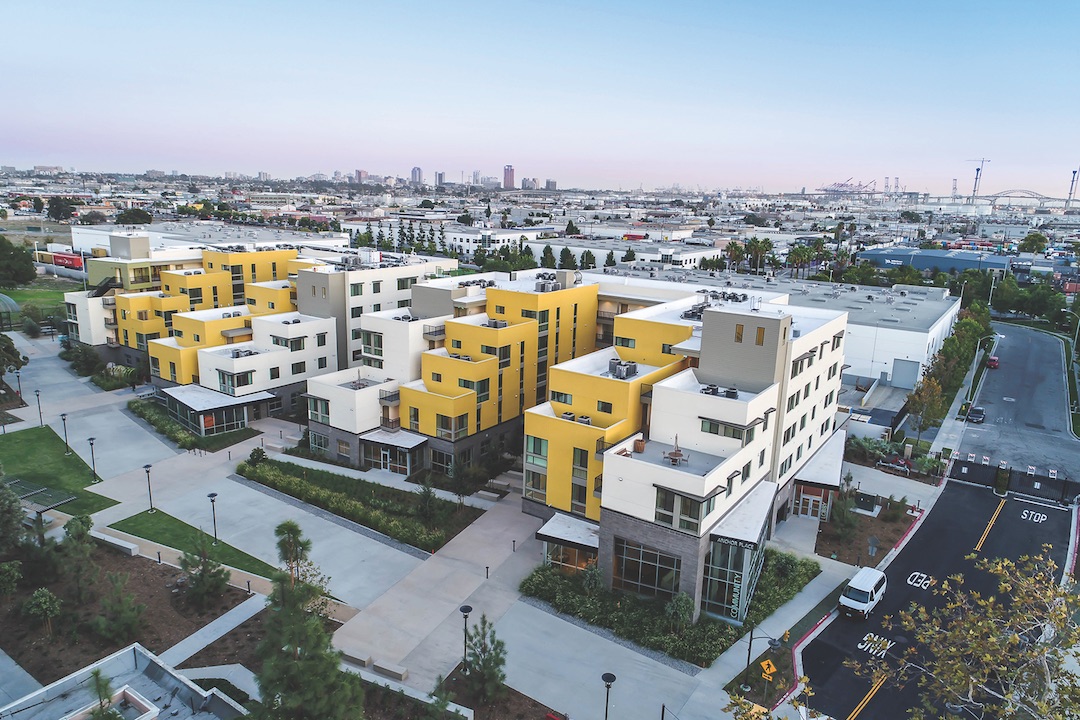The Gold Nugget Awards, known as the “Academy Awards” of residential development, are open to builders, developers, designers, and land planners with projects in the U.S. and around the world. From among the 45 projects that were honored at the Pacific Coast Builders Conference in June, we picked four outstanding Grand Award winners in affordable multifamily housing.
Social priorities shape workforce housing
Five88
>100 units/acre
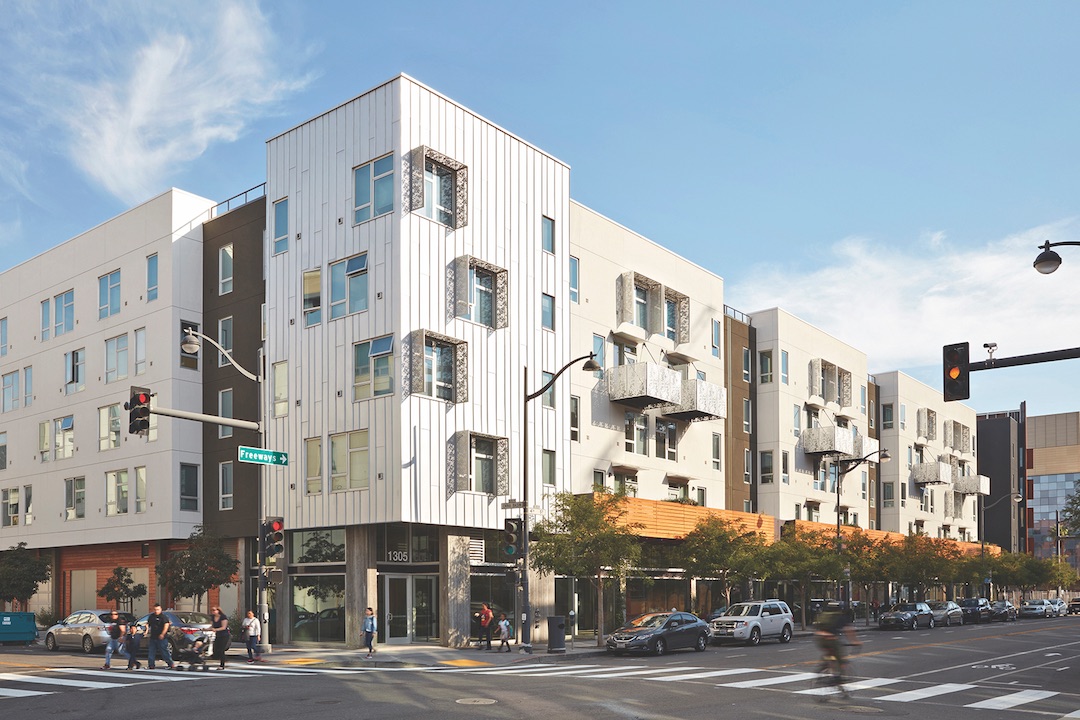 Mariko Reed.
Mariko Reed.
FIVE88 gives priority for affordable workforce housing to residents who work at public education and healthcare institutions and applicants who live or work in San Francisco. Located in a rapidly developing neighborhood near the new UCSF Medical Center, it is the largest 100% affordable development in the city in the last 10 years.
FIVE88 steps down from four stories at the west side of the block to three stories toward the east. It provides 200 apartments—72 one-bedroom residences ($1,090 to $1,320/month) and 128 two-bedroom flats ($1,299 to $1,576/month)—plus 10,079 sf in a retail arcade.
The building wraps around a large communal open space. A second-level courtyard sits atop an embedded garage on the west side and a ground-level courtyard on the east.
FIVE88 earned a Gold GreenPoint rating. Sustainable strategies include domestic solar hot-water panels and drought-tolerant landscaping. As a coastal landfill site, the project required extensive settlement strategies: surface pavers, foundation piles, and tilting stairs at stoops. The project is located along the Fourth Street bicycle route, so the designers set aside 200 secure bicycle parking spaces plus visitor bicycle parking.
PROJECT TEAM | FIVE88
OWNER Related California NONPROFIT DEVELOPER Chinatown Community Development Center ARCHITECT/INTERIOR ARCHITECT David Baker Architects ASSOCIATE ARCHITECT G7A | Architecture + Urban Structural Engineer DCI+SDE Engineers Ce Freyer & Laureta MECHANICAL ENGINEER Tommy Siu and Associates ELECTRICAL ENGINEER Alfa Tech GEOTECHNICAL ENGINEER Rockridge Geotechnical SUSTAINABILITY CONSULTANT Bright Green Strategies LANDSCAPE ARCHITECT GLS Landscape | Architecture CM Construction Resource Management GC Nibbi Brothers General Contractors
It's family living with a scenic falir
Hoa Mai gardens
60-100 units/acre
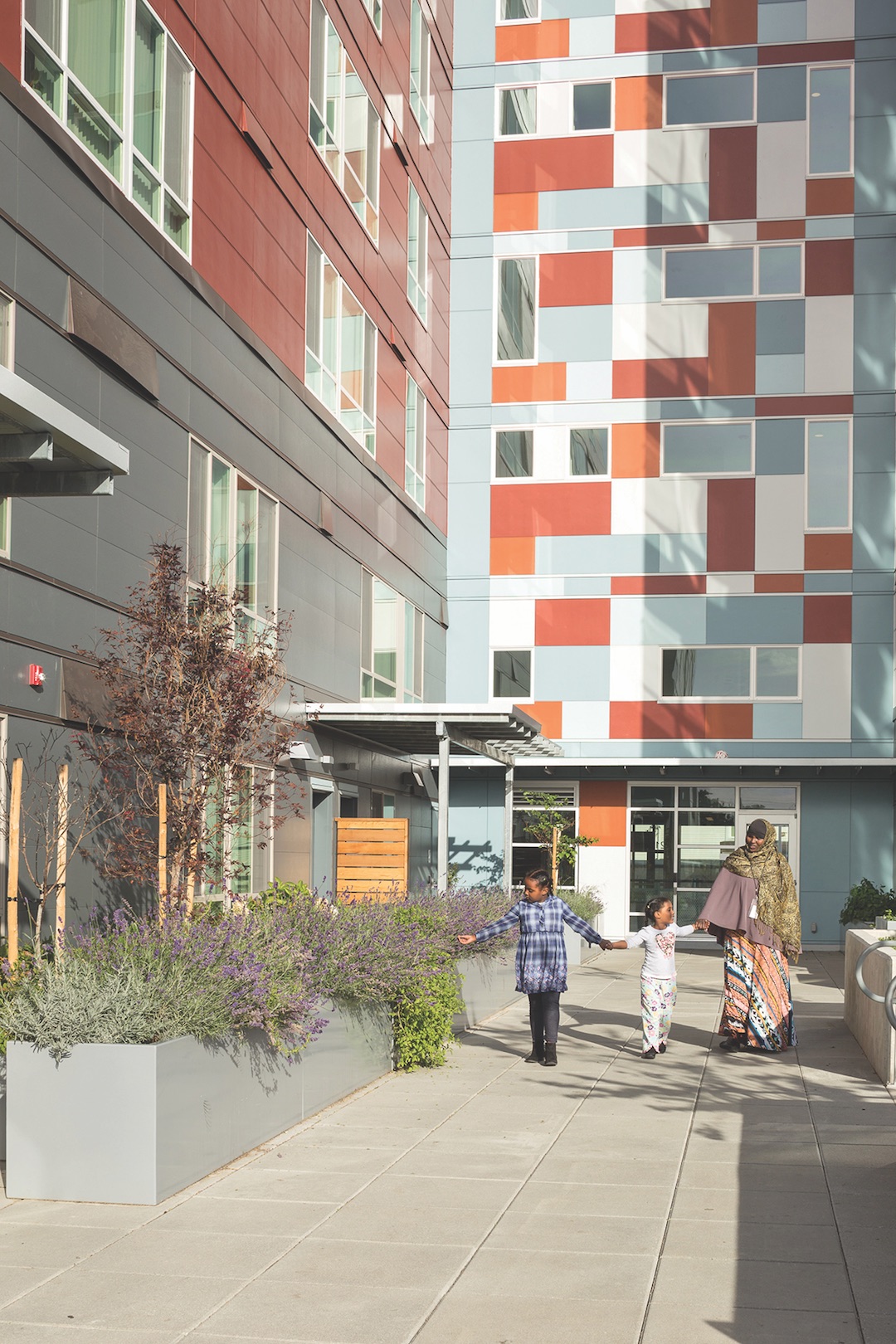 Photo: William Wright Photography.
Photo: William Wright Photography.
Thanks to its L-shaped design, Hoa Mai Gardens offer its residents an impressive scenic lineup: Elliott Bay, the Cascade Mountains, and Mount Rainier. The 111-unit, family-oriented affordable housing complex is the third building in the redevelopment of Seattle’s Yesler Terrace. The property is sited on a steep slope with a risk of landslide, necessitating extensive site stabilization.
The 146,425-sf complex has 51 one-bedroom, 43 two-bedroom, 12 three-bedroom, and five four-bedroom units. The four-bedroom townhome units provide enough space for multigenerational families. All residences are subject to LIHTC rental limits; 70 receive project-based Section 8 subsidy. Average rent: $445/month.
The community has plenty of family-friendly features: a library, units with in-home daycare capability, on-site social and youth services, a 4,014-sf courtyard, outdoor playgrounds, a green roof deck, gardens, and sewing classes.
Hoa Mai Gardens meets the state’s Evergreen Sustainable Development Standard. Its building systems use no fossil fuels. Sustainability features include solar hot water preheat, rainwater harvesting (by Water Control Corp.), and graywater piping systems for toilet flushing. A pedestrian path on the west side connects the project to the Yesler Terrace neighborhood’s network of walking/bicycling paths.
PROJECT TEAM | HOA MAI GARDENS
DEVELOPER Seattle Housing Authority ARCHITECT SMR Architects SE/CE Coughlin Porter Lundeen GEOTECHNICAL GeoEngineers Inc. DEVELOPMENT ENGINEER MIG|SvR BUILDING ENVELOPE JRS Engineering MECHANICAL DESIGN-BUILD CONTRACTOR Auburn Mechanical ELECTRICAL DESIGN-BUILD CONTRACTOR Valley Electric MEP DESIGN-ASSIST/ENERGY MODELING/COMMISSIONING Glumac SUSTAINABILITY CONSULTANT O’Brien & Co. ENVIRONMENTAL CONSULTANT Soundearth Strategies ACCESSIBILITY CONSULTANT Karen Braitmayer, FAIA ACOUSTICS SSA Acoustics PERMITS Permit Consultants NW LANDSCAPE ARCHITECT Fazio Associates GC Andersen Construction
Safe harbor for homeless veterans and families
Anchor Place
30-60 units/acre
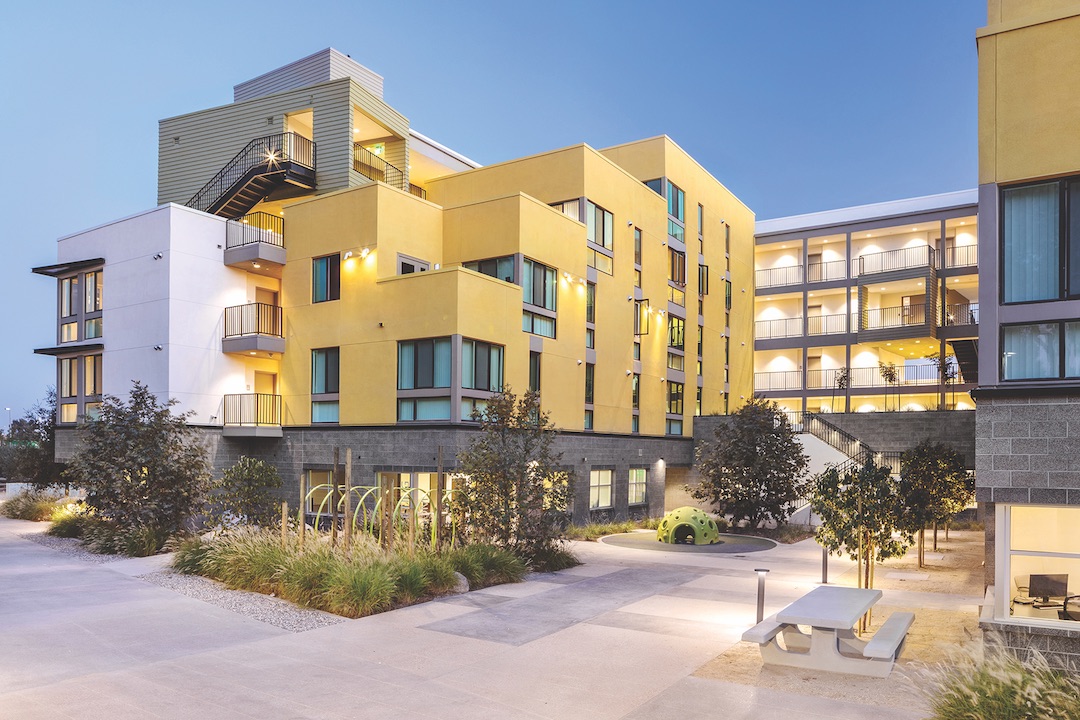 Photo: Panic Studio LA.
Photo: Panic Studio LA.
Anchor Place provides affordable housing for homeless veterans and families. Built as the second phase of the Century Villages at Cabrillo, a 27-acre campus on the site of the decommissioned Long Beach (Calif.) Naval Station, the 120-unit community has 75 apartments set aside for homeless vets and 18 units for homeless families and individuals earning 30-60% of AMI. Rents range from $507 to $845/month for the 95 one-bedroom units; $608 to $1,216 for the 20 two-bedroom units; and $703 to $1,406 for the five three-bedroom residences.
The community has social services offices, a fitness room, laundry rooms, a bike center, a yoga/dance studio, a two-story community room, and a game room. Outdoors, there’s a community garden and three courtyards: one for kids, one for solitude, one for socializing.
In total, the project offers 10,000 sf of community space. It achieved LEED for Homes Platinum status.
PROJECT TEAM | ANCHOR PLACE
OWNER Century Affordable Development, Inc. ARCHITECT The Architects Collective INTERIOR DESIGNER Collaborative House SE David Choy & Associates CE KPFF Consulting Engineers MECHANICAL/ELECTRICAl engineer S.Y. Lee Associates SUSTAINABILITY CONSULTANT Global Green LANDSCAPE ARCHITECT RELM CM Primus GC Walton Construction Services
Multigenerational living 'reimagines' vacant church site
Wesley village
<30 units/acre
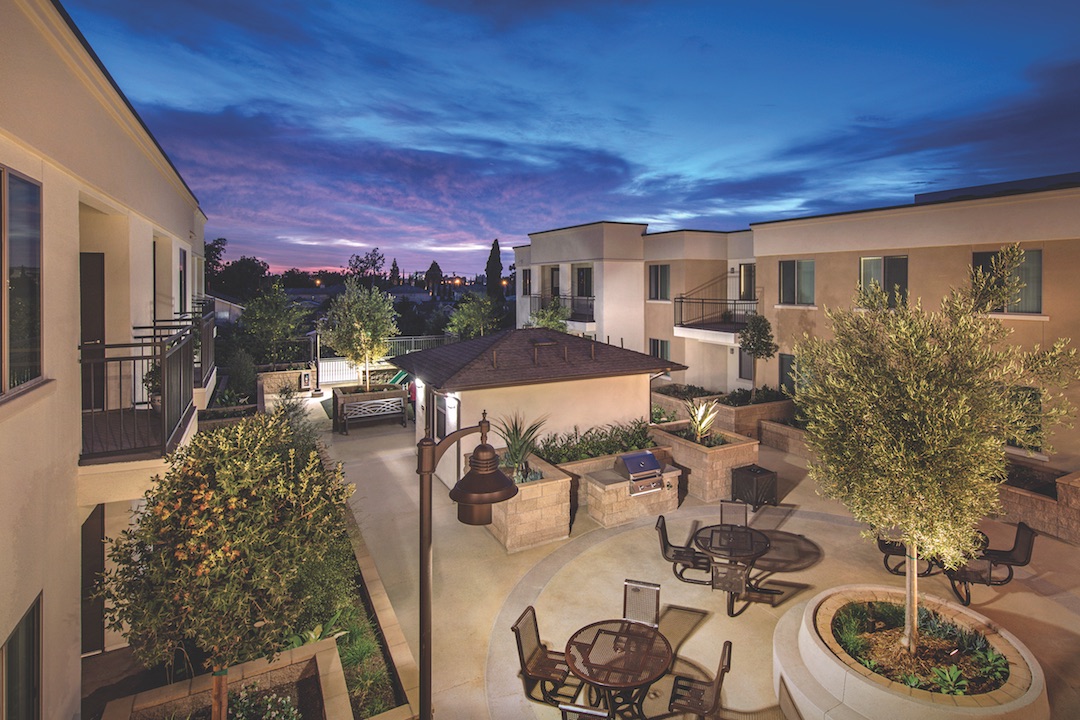 Photo: Juan Tallo.
Photo: Juan Tallo.
Wesley Village, a mixed-use community in Orange County, Calif., features multigenerational housing for families and seniors. The community was built in partnership with the 141-year-old Garden Grove United Methodist Church, the city of Garden Grove, and nonprofit developer Jamboree on the site of a vacant parking lot and unused church land. Wesley Village provides affordable housing for 47 families and seniors, along with 10,000 sf of active open space.
The complex, part of the city’s Re:Imagine Garden Grove program, is formed by two three-story residential buildings—one for seniors (16 units), one for working families (31 units)—and a third building that houses a Head Start learning center, a Boys and Girls Club, an Alzheimer’s care service, the Lestonnac Free Clinic, Project Hope Alliance, and other free educational, health, and wellness services.
A community recreation center has offices, a health clinic, a computer center, a library, and multipurpose rooms. The complex has 20 one-bedroom (813 sf), 11 two-bedroom (885-932 sf), and 15 three-bedroom units (1,126 sf). Wesley Village achieved Gold certification under LEED for Homes.
PROJECT TEAM | WESLEY VILLAGE
DEVELOPER Jamboree ARCHITECT/LAND PLANNER Newman Garrison + Partners INTERIOR DESIGN Collaborative House Structural engineer Wright Engineers MECHANICAL/PLUMBING ENGINEER TAD ELECTRICAL Candela LANDSCAPE ARCHITECT Site Design Studio GC Quality Development and Construction
Related Stories
| Mar 11, 2011
Renovation energizes retirement community in Massachusetts
The 12-year-old Edgewood Retirement Community in Andover, Mass., underwent a major 40,000-sf expansion and renovation that added 60 patient care beds in the long-term care unit, a new 17,000-sf, 40-bed cognitive impairment unit, and an 80-seat informal dining bistro.
| Mar 11, 2011
Mixed-income retirement community in Maryland based on holistic care
The Green House Residences at Stadium Place in Waverly, Md., is a five-story, 40,600-sf, mixed-income retirement community based on a holistic continuum of care concept developed by Dr. Bill Thomas. Each of the four residential floors houses a self-contained home for 12 residents that includes 12 bedrooms/baths organized around a common living/social area called the “hearth,” which includes a kitchen, living room with fireplace, and dining area.
| Mar 11, 2011
Texas A&M mixed-use community will focus on green living
HOK, Realty Appreciation, and Texas A&M University are working on the Urban Living Laboratory, a 1.2-million-sf mixed-use project owned by the university. The five-phase, live-work-play project will include offices, retail, multifamily apartments, and two hotels.
| Mar 1, 2011
How to make rentals more attractive as the American dream evolves, adapts
Roger K. Lewis, architect and professor emeritus of architecture at the University of Maryland, writes in the Washington Post about the rising market demand for rental housing and how Building Teams can make these properties a desirable choice for consumer, not just an economically prudent and necessary one.
| Feb 15, 2011
New Orleans' rebuilt public housing architecture gets mixed reviews
The architecture of New Orleans’ new public housing is awash with optimism about how urban-design will improve residents' lives—but the changes are based on the idealism of an earlier era that’s being erased and revised.
| Feb 11, 2011
Chicago high-rise mixes condos with classrooms for Art Institute students
The Legacy at Millennium Park is a 72-story, mixed-use complex that rises high above Chicago’s Michigan Avenue. The glass tower, designed by Solomon Cordwell Buenz, is mostly residential, but also includes 41,000 sf of classroom space for the School of the Art Institute of Chicago and another 7,400 sf of retail space. The building’s 355 one-, two-, three-, and four-bedroom condominiums range from 875 sf to 9,300 sf, and there are seven levels of parking. Sky patios on the 15th, 42nd, and 60th floors give owners outdoor access and views of Lake Michigan.
| Feb 11, 2011
Sustainable community center to serve Angelinos in need
Harbor Interfaith Services, a nonprofit serving the homeless and working poor in the Harbor Area and South Bay communities of Los Angeles, engaged Withee Malcolm Architects to design a new 15,000-sf family resource center. The architects, who are working pro bono for the initial phase, created a family-centered design that consolidates all programs into a single building. The new three-story space will house a resource center, food pantry, nursery and pre-school, and administrative offices, plus indoor and outdoor play spaces and underground parking. The building’s scale and setbacks will help it blend with its residential neighbors, while its low-flow fixtures, low-VOC and recycled materials, and energy-efficient mechanical equipment and appliances will help it earn LEED certification.
| Feb 11, 2011
Apartment complex caters to University of Minnesota students
Twin Cities firm Elness Swenson Graham Architects designed the new Stadium Village Flats, in the University of Minnesota’s East Bank Campus, with students in mind. The $30 million, six-story residential/retail complex will include 120 furnished apartments with fitness rooms and lounges on each floor. More than 5,000 sf of first-floor retail space and two levels of below-ground parking will complete the complex. Opus AE Group Inc., based in Minneapolis, will provide structural engineering services.
| Jan 27, 2011
Perkins Eastman's report on senior housing signals a changing market
Top international design and architecture firm Perkins Eastman is pleased to announce that the Perkins Eastman Research Collaborative recently completed the “Design for Aging Review 10 Insights and Innovations: The State of Senior Housing” study for the American Institute of Architects (AIA). The results of the comprehensive study reflect the changing demands and emerging concepts that are re-shaping today’s senior living industry.
| Jan 21, 2011
Harlem facility combines social services with retail, office space
Harlem is one of the first neighborhoods in New York City to combine retail with assisted living. The six-story, 50,000-sf building provides assisted living for residents with disabilities and a nonprofit group offering services to minority groups, plus retail and office space.


